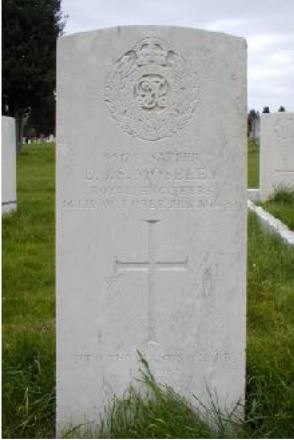3rd Reserve Battalion, Royal Engineers

Edwin John Stephen Moseley was born in Gloucester on 16 September 1882, the son of Edwin John and Ellen (née George).
Edwin (junior) married Edith Rhona Hamblin at Gloucester on 3 June 1905. The couple had seven children between the years 1905 and 1912. At the time of the 1911 Census the family (then comprising parents and five children) lived at 43 Moor Street, Tredworth, Gloucester. Edwin’s occupation was a plumber. For about six months, commencing 23 November 1901 he had been employed by the Great Western Railway.
On 13 April 1915, at the age of 32 years and 6 months Edwin attested for service in the Army for the duration of the war. As a plumber he requested service with the Royal Engineers. After undergoing training at the Base Depot (with No 6 Depot Company) he was posted to join the British Expeditionary Force (BEF) in France on 19 November 1915, where he joined 70A Field Company, part of 12th (Eastern) Division, Royal Engineers.
On 29 February 1916 he received gun shot wounds to the head, right arm, back and legs and was sent back to the UK on 17 March 1916 and was posted to the strength of the Dismounted Training Company at Newark, Nottinghamshire (which later became 3rd Reserve Battalion, Royal Engineers). No details of his treatment for wounds appear in the few papers contained in his surviving pension record. He was discharged from the Army as no longer fit for war service on 13 February 1917. He had served for a total of one year and 307 days. His discharge papers refer to his character as being ‘very good’ and that his ‘conduct has been very satisfactory: he is a good plumber’. He was issued with a Silver War Badge to signify discharge from military service on health grounds.
According to a recently released Pension Record Card the cause of Edwin’s death on 14 October 1918, age 36, was acute lobar pneumonia. No report of his death or funeral appear in the local newspapers. He was buried in Gloucester Old Cemetery, near to his Tredworth home, where a standard CWGC headstone now marks his grave. He is commemorated on the Gloucester War Memorial.
His wife never re-married and died in 1966.
Researched by Graham Adams 1 September 2019 (revised 4 August 2021)
